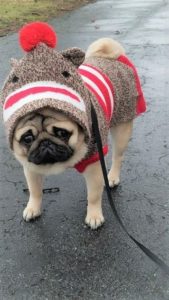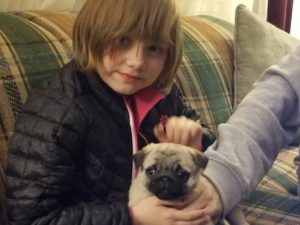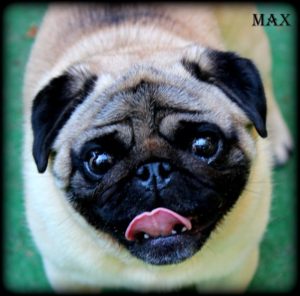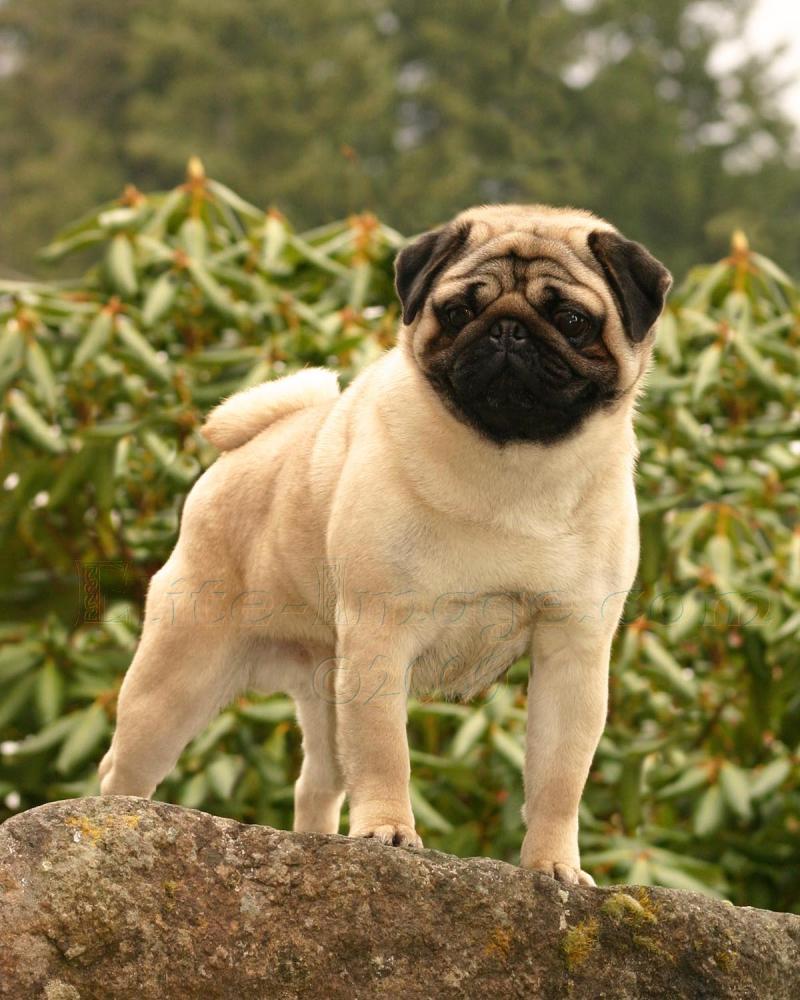Dogs occupy many roles in history, but few breeds embrace the cuddling role as heartily as the Pug. Originating in China over 2000 years ago, a Pug’s job was one of loyal companion warming the lap of royalty. They have come through history as engaging companions eager to please.
The Pug is a brachycephalic breed characterized by wrinkled faces and flat noses. Their skull shape accounts for the snorting, panting, and snoring Pugs are known for. But they offer so much more!
Your Pug won’t recognize your personal space
Having no sense of personal space, your Pug will sleep with you, sit with you, and be your constant shadow. If you land where there’s no room to share, they will plop down on your feet. They crave your attention and have loads of crazy antics they will use to get it.
The Pug is a small sturdy breed that will keep young and old entertained with their charming nature. They get along well with other dogs, cats, small animals, kids. Their laid back personality they even tolerate costumes well!
 Pugs will choose a favorite person but will share their love with all family members. They make excellent family dogs. Being small and relatively lazy (they can sleep up to 14 hours a day), they are well suited to apartment living.
Pugs will choose a favorite person but will share their love with all family members. They make excellent family dogs. Being small and relatively lazy (they can sleep up to 14 hours a day), they are well suited to apartment living.
Pugs need to watch their waistlines and they won’t like it
Pugs love to eat and will eat anything they think is edible, so supervision is key. When eating, they gulp the food down quickly. This can create air bubbles in their stomachs. Dog bowls suited for flat-faced dogs will help them eat more efficiently.
Another well-known Pug trait is flatulence—the byproduct of gulping food. It may not end the gas, but it can decrease it. Healthy food will also help reduce the gas problem.
Treats can be another problem for Pugs. They gain weight easily and are skillful beggars. Healthy snacks will keep your dog at an appropriate weight. You can offer lean meat treats, small pieces of carrot or apple, and green beans.
Exercise is essential, but your Pug is no athlete
Pugs also need regular exercise to keep their weight down. They aren’t athletic dogs, so a brief walk or two daily along with a game of fetch will do them well. Offering a mental stimulation toy can also keep your Pug moving during the day.
Mood and tone matter to the intuitive Pug, especially when training
Training time is relatively easy. Pugs are highly food motivated and intelligent. They are also sensitive and intuitive to your mood and tone. Positive reinforcement training methods are very effective with this breed.
Yet, some Pugs can be stubborn when house training and take more time to master it. There are breeders that litter box train their pups, making this process much easier, but not all do. If your pup is having trouble, repetition and patience are key.
A Pug is a lover, not a fighter
Pugs are dependable watchdogs. This breed is not prey driven, preferring to welcome any newcomers. But they are very alert to their surroundings and will bark if something seems amiss.
Pug Hair could become a condiment in your home without regular grooming
Pugs shed a LOT because their fur is denser than most breeds. They have a topcoat and an undercoat and the growth cycle (growth, rest, shed) is faster than other dogs. Shedding is a constant for these dogs.
Regular grooming is essential if you don’t want to have a house full of Pug hair. Daily brushing and using a Furminator or shedding blade works well. Monthly bathing also helps reduce the shedding problem.
Many Pugs have allergy issues. It’s one reason they get surrendered to shelters and is easily preventable. Try foods that are high quality with essential fatty acids to keep their skin and coats in top condition.
Hot weather and Pugs don’t mix well.
Pugs, having the brachycephalic skull shape, have smaller air passages. It’s harder for them to cool themselves in weather hotter than 80 degrees. When the weather is hot, plan walks and outdoor time for cooler periods of the day. This will help avoid heat exhaustion or heat stroke.
Pugs may have some health problems
Being a small brachycephalic breed, the Pug is prone to several health issues. The problems range from respiratory problems to hip and knee problems. But not all Pugs will have these problems. Reputable breeders provide line genealogy and health records of parents.
Pugs that don’t want to cuddle are rare, but there are some

Knowing the difference between a hug and a cuddle might help if your Pug seems aloof. The Pug in the picture looks uncomfortable and the difference in hugging and cuddling could help with his stress level.
A hug is putting both arms around your dog and holding them. If your dog seems uncomfortable and tries to move away, the hug could make them feel trapped. Some dogs can get very stressed since it goes against their instincts.
A cuddle is when your dog lays or sits up against you. Pugs usually want to sit with you wherever you land and sleep with you if you’ll allow it. But, if your Pug doesn’t, try these tips to encourage closeness:
- Give them time
- Bribe them with a healthy treat
- Pet them often
With Patience, your Pug may welcome closeness. Yet, some dogs don’t, preferring to sit near you rather than with you.
10 Interesting Pug Facts
- The first dog with Covid-19–The first dog testing positive with Covid-19 in the United States was a Pug in North Carolina.
- Colors—The AKC recognizes two colors as the breed standard: Fawn and Black.
- Not swimmers—Pugs are not adept swimmers, and should wear a swimming harness when near water.
- A group of Pugs is called a Grumble—In Holland, they are referred to as Mopshund, which means “to grumble.”
- Prized Companions—Being highly valued, Soldiers guarded royal pugs in ancient history.
- Perfect tailsA Pug tail curls up toward their body. The ideal Pug tail, according to AKC standards, has two curls.
- Pug with an MBA—in 2009, a Pug named Chester Ludlow earned an MBA in Finance from Rochville University.
- The reason for the wrinkles—It’s said the wrinkles on a Pug head are Chinese characters for Prince.
- Are Males or Females better? Some believe males are more cuddly and attentive. Females will take a guardian role, being more alert to their surroundings.
- Pug Tail tells a tale—A Pug’s tail will uncurl when they relaxed, or get tired
Is a Pug for you?

Do Pugs like to cuddle? The quick answer is yes, they sure do. Life with Pugs can be challenging and sweet at the same time.
With so many products available to make life with Pugs easier, their silly personalities and sweet temperaments make them well worth looking into. After all, who doesn’t want a loyal cuddle master to share life with?
Are you charmed by the Pug Breed? Tell us your thoughts in the comments below.

